By Brian Alm. Published on Egyptological, June 30th 2011, Magazine Edition 1
Introduction
This article, the first of a five-part series on Ancient Egyptian religion, will lay these conceptual foundations for all that follows: cosmic order, maat; duality, the balance of binary aspects of a whole; and magic, heqa, which makes everything possible. Subsequent articles will cover the major theologies, creation myths and associated deities, resurrection and eternity, and the religion as it is expressed in temple and tomb architecture, ritual, art and writing.
Part 1: The Conceptual Foundations
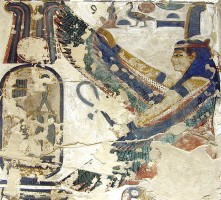
The goddess Maat, with characteristic feather, from the tomb of Seti I (KV17). Photo by Jean-Pierre Dalbéra 2002, Luxor
Egyptian religion can seem overwhelming. To comprehend this immensity of thought and expression over such a vast gulf of time, where do we begin? The answer: Begin with maat.
It may seem frivolous to suggest that a culture as long and complex as ancient Egypt’s can be captured in a word, but from a fundamental understanding of maat, we can proceed to everything else — the social and civil order, the Egyptians’ concepts of the natural and supernatural worlds, and above all, the religion. In fact, every aspect of their culture was rooted in religion. It was so central to the Egyptians’ lives that they didn’t even have a word for “religion” per se, as something distinct from their daily lives. And religion was grounded in maat and its balancing concept chaos (isfet).
Religions seek to address some universal questions that occur to people as human intelligence matures and they begin to contemplate the natural world and their own destiny, both here and beyond. How did it all begin? Are we alone? Surely not — there had to be some first being larger than ourselves with the power to create the heavens and the Earth, and also with the will to do so. What does it all mean? What is our relationship with this great being? How can we avail ourselves of that supernatural power and prevail over natural forces and even our own destiny? Is there something beyond this life for us? What should we be doing while we’re here in order to secure our future in that world beyond? And so religion and ethics take root in thought. Only a divine being could possess both the power and the will to do all that obviously had been done.
Maat

For the Ancient Egyptians, chaos was very close at hand: the desert (Deshret, the Red Land) was a deadly and very real metaphor of a world without order.
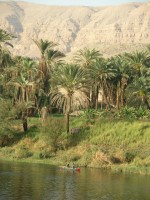
The life-giving River Nile brought fertility to the land the Egyptians called Kemet (the Black Land). The transition from fertility to desolation is not gradual; where the green stops, the desert starts.
through the hostile desert. They called the land in the river valley Kemet (the Black Land), where abundant water and fertile soil meant life. Deshret (the Red Land), the desert beyond the valley, meant death. And the transition from fertility to desolation is not gradual. You could almost draw a line between where the green agricultural land stops and the desert starts. So in this very basic observation of the natural world, order is defined by its polar opposite, chaos. That philosophical understanding of order over chaos then becomes theology.
Books often reduce the idea of maat to a simple, single term, “justice” or “truth” or “order.” And indeed it is all three, but it is much bigger than that: it is cosmic order. Maintaining cosmic order is paramount. Order holds back chaos and the disintegration of all that is. More immediately and practically, without cosmic order the Nile doesn’t flood, drought leads to famine, the social and civil order is lost, and Egypt is left vulnerable to forces beyond its control.
To upset order in the earthly sphere is to imperil the universe. And so it is the duty of humankind (that is, Egyptians) to uphold the civil and social order through their devotion to the king. As the semi-divine son of the sun god Ra and the living Horus, the king’s primary function is to maintain the order of the universe by maintaining order on Earth. Ra depended on maat, which was deified as the goddess Maat, his daughter. Bringing this down to Earth, “Divinity, and thus creation, subsisted because social cohesion was respected.” (Traunecker 2001, p. 97) We shall return to the role of the king in religious ritual later in this series. For now let’s simply note this apostolic responsibility: the divine forces that had formed the universe put Egypt at its center and left the king in charge.
The time before the world was created (the “First Time”) was an infinity of darkness, silence and chaos. The universe was a primordial ocean called Nun, and just as in Genesis, it was without form, and void. The first land to emerge from this water was Egypt. The Egyptians knew that water was both above and below Earth: rain came down and well water came up, so the dark nothingness that was beyond the habitable realm had to be water. With the Creation, order took form and Egypt appeared.
Order on Earth and order in the universe are binary and complementary; then it follows that in diversity there is unity, so a thing can be both many and one. This will explain much, as we delve into the religion of Egypt and encounter contradictions that, to our modern minds, might otherwise seem mysterious.
Duality

The Temple of Isis at Philae illustrates the temple orientation on an east-west axis, replicating the course of the sun; temple pylons, always in pairs, reflect the idea of duality, or balanced order, that informed the Egyptian way of thinking.
Chaos and order are the first of many dualities that inform the Egyptian way of thinking. “The concept that harmony was embodied in balanced opposites was fundamental in Egyptian thought” (Wilkinson 2008, p. 70), and so dualities abound. The diurnal cycle of the sun is balanced as day and night. Male and female together produce life. Temples are built on two axes; temple pylons, always in pairs.
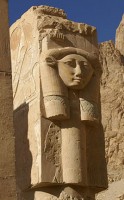
The kindly Hathor was the goddess of love, music, dance, feminine grace and all good things, but when enlisted by Ra to wreak havoc on rebellious mankind she became the vicious lionness Sekhmet.
Principles, or natural laws, are set in balance, deified, often anthropomorphized, and explained mythologically. The sun, which ruled the day, was balanced by the moon, at night, and these heavenly bodies were deified as Ra and Thoth (Djehuty), and also as the two eyes of the falcon Horus, originally a god of the solar pantheon and later morphed into the anthropomorphic son of Osiris and Isis. Gods and goddesses were paired as husbands and wives — the Egyptians were always mindful of family relationships and sexual union — or, more cerebrally, as the binary representation of a principle or natural law. A deity might have dual aspects: Nephthys (Nebthet) was the goddess of both fertility and barrenness; kindly and loving Hathor, enlisted by Ra to wreak havoc on rebellious mankind, became the vengeful lionness Sekhmet; Serket, the scorpion goddess, could be deadly but also provided protection from scorpions.
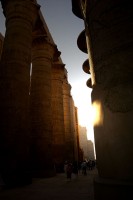
The sun, which ruled the day, was balanced by the moon at night, and these heavenly bodies were deified as Ra and Thoth (Djehuty).
The Egyptians were astute observers of nature, and their land was an ideal place for observation. Philosophy and theology followed these observations. Water sustains life, but you can also drown in it; the annual flood brings fertility to the valley, but too much water destroys the crops, so Hapy, god of the Inundation, is opposed by Anuket, who keeps the river in its banks. The positive and negative aspects inherent in vicious animals like the crocodile are simply binaries of the indivisible whole and are consistent with the natural order. “Ambivalence was characteristic of Egyptian thought … Egyptians conceived of nature as an unchanging whole whose components were necessary.” (Traunecker 2001, p. 16)
As a way of understanding order, duality made sense. Two things in balance meant equilibrium, and a binary whole was inseparable — with one important exception: stasis versus change. The Egyptians were the ultimate conservatives; they wanted stability because stability meant order, whereas change meant uncertainty. Order was paramount.
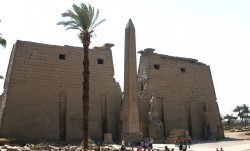
Consistent with Egypt's penchant for representing duality, the Temple of Luxor originally had two obelisks, but in the 1830s one of them was given to France.
This dualistic reckoning of reality led the Egyptians to understand their relationship to the divine, and to understand the gods’ and goddesses’ relationships to each other; it also explained how a deity could possess both positive and negative aspects and be both benign and malevolent.
Duality does not, however, require a polarity of positive and negative aspects; it is simply an orderly pairing of two things. Balance inheres in the binary association of things, and therefore duality in any sense is a function of maat — divinely established and humanly preserved cosmic order.
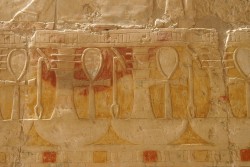
For both the present, physical life on Earth and the afterlife in the spiritual realm the Egyptians used the same word, ankh, shown as a cross with a loop.
Duality also addresses the ultimate human question about life after death. Death was not the end of life, but simply a portal through which one went from life in this world to a continuation of life in the next. For both the present, physical life on Earth and the afterlife in the spiritual realm, the Egyptians used the same word, ankh. Both were aspects of one reality: life.
It can be difficult to grasp that a belief system can incorporate two apparently contradictory ideas simultaneously. We understand that both positive and negative charges are necessary in magnetism and electricity, but when faced with polarized ideas, we see the matter as elective. The Egyptians didn’t have to choose one over the other; they could accept both at once as complementary aspects of the same reality.
And so we find oddities that would otherwise seem bewildering, such as kings named after Seth, the principle of disorder, who murdered his brother Osiris and threatened the rightful order of succession by trying to seize the throne from his nephew Horus. A papyrus says of a man who can’t control his drinking and temper, “Seth is the god within him.” But Seth was also the stalwart protector of Ra, defending him from the serpent Apep who lurked in the waters of the night, intent on swallowing the sun and annihilating divine order. For all of Seth’s faults, he also represented strength, courage and determination, which were much admired in Egypt. Joann Fletcher argues that “Seth cannot be dismissed as ‘evil,’ for his presence was seen as an essential counterweight to the order represented by Horus.” (Fletcher 2009, p. 67). Seth is one of many binary ideas in ancient Egypt.
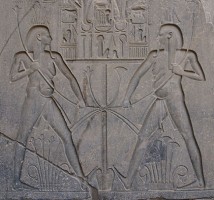
Sema-Tawy, a "binding of the Two Lands," ties the lotus of Upper Egypt and the papyrus of Lower Egypt together.
Even the language accommodated the notion of duality: the idea of two things was expressed with a dual form, ending in –wy or –y. For more than two there was a plural form. Upper and Lower Egypt were unified in 3100 BCE or so, but nevertheless the country was always called the Two Lands. The unification was celebrated in the term Sema-Tawy, a “binding of the Two Lands,” which was also a sculptural rendering of the lotus (the water lily) of Upper Egypt and the papyrus of Lower Egypt.
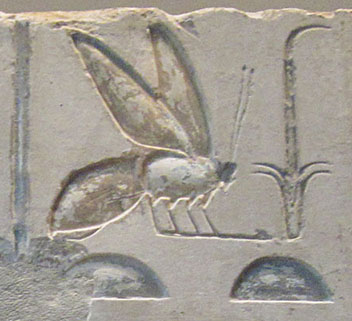
Nesu-Bity, Ruler of the Sedge and the Bee, referring to the sedge plant of Upper Egypt and the Bee of Lower Egypt
The king was called Lord of the Two Lands (Neb Tawy) and Ruler of the Sedge and the Bee (Nesu-Bity), referring to the sedge plant of Upper Egypt and the bee of Lower Egypt. Among the five names in the king’s full titulary was the Two Ladies (Nebty) name, combining the vulture goddess Nekhbet of Upper Egypt and the cobra goddess Uadjet of Lower Egypt. The sekhemty, or pshent, crown, was a combination of the white crown (hedjet) of Upper Egypt and the red crown (deshret) of Lower Egypt. Dualities are affirmations of maat: eternal truth, justice (balance) and order.
Dualities helped support and explain order, but still Creation and the natural and supernatural forces were mysterious and beyond human understanding. Magic filled the gaps.
Heqa
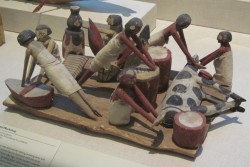
A model of a workshop in a tomb magically came alive - here livestock was butchered and prepared for the table of the deceased. In eternity, life went on
The Egyptians believed totally in magic (heqa), which, according to the Coffin Texts, existed in the primordial nothingness; therefore, heqa was the force that empowered Creation. Now, if they recited the right spells, people could put the power of heqa at their disposal. There was, as Fletcher says, “no distinction between religion and magic. The Egyptians believed it was possible to alter their world by directing unseen forces.” (Fletcher 2009, p. 110)
Numbers were magical. In addition to the number two, other numbers also put things in order. Seven and multiples of seven, for instance: Ra had seven Bas and 14 Kas; Seth chopped Osiris into 14 pieces; there were 14 false doors in Djoser’s pyramid; in the Hall of Two Truths, or Hall of Double Justice, the dead presented themselves for Judgment and addressed the 42 petitions of the Negative Confession to 42 judges; Egypt had 42 nomes (provinces, Egyptian sepatu); 70 days were required for the embalming and mummification process and the accompanying rituals; and 70 days after the death of the king, the new king was crowned.
The Egyptians’ favorite star was Sirius (in Egyptian Sopdet, and in Greek Sothis). Some stars were always there, fastened in place. These were the circumpolar stars, “the imperishable ones.” Some stars wandered; they were the five known planets. But one in particular — Sirius — disappeared, and then magically returned, every year, without fail, after 70 days. Its reappearance signaled the new year, which began July 20, but also testified to the regularity of heavenly events, which — in addition to the diurnal cycle of the sun — confirmed the truth of order, magic, and, as we will see later on, resurrection.
Other numbers with great symbolic meaning were four, eight and nine, which will figure importantly in the next part of this series, and three, which deserves special note now. Three expressed plurality; three times three, nine, was the “plural of plurals” and took on mythic meaning: the Nine Bows were a symbol of Egypt’s foreign adversaries, often used to decorate the king’s footstool, so he could trample them and demonstrate his dominion over them; imposing order on Earth had cosmic significance. Richard H. Wilkinson has a fascinating discussion of various number systems in The Complete Gods and Goddesses of Ancient Egypt, 2003, pp. 74-79. Among his observations, for example, is that the number four expressed totality, so 4 [totality] + 3 [plurality] = the magic number 7.
Magic was not an imaginary force, but real. It was the foundation of art and, especially, writing. Reality was created by the magic of words and art. In a tomb an inscription that praised a person’s deeds magically made it all true (unless it was defaced). Kings could claim victory in battles no matter what the real outcome was; a scribe could write down something that never happened and it became fact.
In art, to picture something was the same as the thing itself. Draw a pitcher of wine, and it’s wine. Form loaves of bread out of stone and place them in the tomb and they will sustain the Ka of the dead forever. Paintings in the tombs show youthful, trim and handsome people, full of vigor. Women have perfect figures — but their clothes often seem too tight to actually allow movement. Some kings lived to be old men, but there they are, young, fresh and virile.
Magic was everywhere, from cradle to grave, and beyond. Amulets protected people in life, and later in death — especially the heart scarab, which was wrapped in the mummy’s bindings right over the heart to keep the heart (the seat of mind, memory and will) from betraying the dead at the time of Judgment by blurting out some dark secret. Magic could prevent such embarrassments.
Little mummiform statues called shabtis (“answerers”) were placed in the tomb to serve the dead in Eternity. A picture of a snake or scorpion would protect people from snakes or scorpions. Apotropaic (protective) knives and wands protected people from evil spirits. Deities were pictured wielding knives in defense of those who counted on their magical protection. Everything was possible through magic, but only if words were used to give the magic its power. “Hieroglyphs” is a Greek term. The Egyptians themselves called them medu-netjer, “the words of god.”
Everywhere you see two hieroglyphs, one the familiar ankh sign, “life,” and the other an upside-down V, or lambda-like sign, which together stamp the foregoing statement as a living fact: di ankh, “given life.”
Order, duality and magic. In the articles to come, we will see how these concepts inform theology, cosmogony, temple and funerary ritual, art and architecture.
References
Fletcher, Joann. 2009, The Egyptian Book of Living & Dying, Duncan Baird, London
Traunecker, Claude. 2001, The Gods of Egypt, Cornell U.P., Ithaca, N.Y.
Wilkinson, Richard H. 2003, The Complete Gods and Goddesses of Ancient Egypt, Thames & Hudson, New York
Credits
Unless otherwise stated, photographs by Brian Alm
Biography
Brian Alm, br_alm@yahoo.com, M.A., University of Chicago, is a retired magazine editor and former university instructor, and now an amateur Egyptologist and adjunct professor in Rock Island, Illinois, U.S.A., where he lectures on Egyptology as an independent scholar.
Plagiarism: All of this comes from my own knowledge, accumulated from study over a number of years. I have not knowingly plagiarized, but obviously the knowledge was generated from copious reading, so it’s conceivable that a phrase lodged in my mind came from somewhere sometime, and of course much of what I have said has been expressed by others in some form. In any case, my approach to the topic and construction of the presentation are my own.
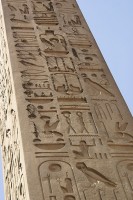
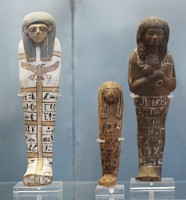
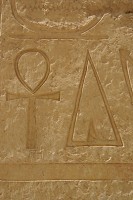
 By
By